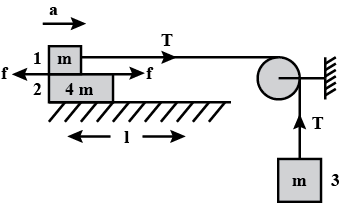
In figure block 1 has one fourth mass and one fourth length of block 2 (mass $4m$ and length $l$. No friction exists between block 2 and the surface on which it rests. Coefficient of friction is ${{\mu }_{k}}$ between 1 and 2. The distance block 2 moves when only half of block 1 is still on block 2 is $\dfrac{n{{\mu }_{k}}l}{8\left( 2-3{{\mu }_{k}} \right)}$. Then find the value of $n$.


Answer
576.6k+ views
Hint: First of all, the forces should be equated by considering the forces of friction, gravitation force and tension also. Then we have to calculate the relative acceleration between the blocks. From that the time taken to move should be calculated and finally the distance travelled is found using this, and the comparison will give the value of $n$ as the answer.
Complete step by step answer:

Let us consider the block 1 first,
$T-F=ma$………………………. (1)
Consider the block 3,
$mg-T=ma$……………………… (2)
From this two equation, equation (1) and (2),
\[mg-F=2ma\]
As we know
\[F={{\mu }_{k}}mg\]
Substituting it in this equation,
\[mg-{{\mu }_{k}}mg=2ma\]
From this after rearranging, we can write that,
\[a=\dfrac{g\left( 1-{{\mu }_{k}} \right)}{2}\]
Now let us consider the block 2,
\[F=4m{{a}_{2}}\]
After rearranging we can write that,
\[{{a}_{2}}=\dfrac{{{\mu }_{k}}mg}{4m}=\dfrac{{{\mu }_{k}}g}{4}\]
Therefore we can write that, the relative acceleration between block 1 and 2 is given by,
\[\begin{align}
& {{a}_{r}}=a-{{a}_{2}}=\dfrac{g\left( 1-{{\mu }_{k}} \right)}{2}-\dfrac{{{\mu }_{k}}g}{4} \\
& =\dfrac{2g-3{{\mu }_{k}}g}{4} \\
& =\dfrac{g\left( 2-3{{\mu }_{k}} \right)}{4} \\
\end{align}\]
Now the time taken to move \[\left( \dfrac{l}{2} \right)\] distance is\[t\],
Therefore the distance moved by the block 2 is\[x\],
\[\begin{align}
& x=\dfrac{1}{2}{{a}_{2}}{{t}^{2}}=\dfrac{1}{2}\times \dfrac{{{\mu }_{k}}g}{4}\times \dfrac{4l}{g\left( 2-3{{\mu }_{k}} \right)} \\
& =\dfrac{4l{{\mu }_{k}}}{8\left( 2-3{{\mu }_{k}} \right)} \\
\end{align}\]
Compare this equation with the equation given in the question will be,
$\dfrac{n{{\mu }_{k}}l}{8\left( 2-3{{\mu }_{k}} \right)}$
$=\dfrac{4{{\mu }_{k}}l}{8\left( 2-3{{\mu }_{k}} \right)}$
Therefore it is understood that
$n=4$
Therefore the value of $n$ is determined.
Note:
Friction is the force which prevents the relative motion of solid surfaces, fluid layers, and material elements sliding against each other. There are so many types of friction. Dry friction is a force that prevents the relative lateral motion of two solid surfaces in contact.
Complete step by step answer:

Let us consider the block 1 first,
$T-F=ma$………………………. (1)
Consider the block 3,
$mg-T=ma$……………………… (2)
From this two equation, equation (1) and (2),
\[mg-F=2ma\]
As we know
\[F={{\mu }_{k}}mg\]
Substituting it in this equation,
\[mg-{{\mu }_{k}}mg=2ma\]
From this after rearranging, we can write that,
\[a=\dfrac{g\left( 1-{{\mu }_{k}} \right)}{2}\]
Now let us consider the block 2,
\[F=4m{{a}_{2}}\]
After rearranging we can write that,
\[{{a}_{2}}=\dfrac{{{\mu }_{k}}mg}{4m}=\dfrac{{{\mu }_{k}}g}{4}\]
Therefore we can write that, the relative acceleration between block 1 and 2 is given by,
\[\begin{align}
& {{a}_{r}}=a-{{a}_{2}}=\dfrac{g\left( 1-{{\mu }_{k}} \right)}{2}-\dfrac{{{\mu }_{k}}g}{4} \\
& =\dfrac{2g-3{{\mu }_{k}}g}{4} \\
& =\dfrac{g\left( 2-3{{\mu }_{k}} \right)}{4} \\
\end{align}\]
Now the time taken to move \[\left( \dfrac{l}{2} \right)\] distance is\[t\],
Therefore the distance moved by the block 2 is\[x\],
\[\begin{align}
& x=\dfrac{1}{2}{{a}_{2}}{{t}^{2}}=\dfrac{1}{2}\times \dfrac{{{\mu }_{k}}g}{4}\times \dfrac{4l}{g\left( 2-3{{\mu }_{k}} \right)} \\
& =\dfrac{4l{{\mu }_{k}}}{8\left( 2-3{{\mu }_{k}} \right)} \\
\end{align}\]
Compare this equation with the equation given in the question will be,
$\dfrac{n{{\mu }_{k}}l}{8\left( 2-3{{\mu }_{k}} \right)}$
$=\dfrac{4{{\mu }_{k}}l}{8\left( 2-3{{\mu }_{k}} \right)}$
Therefore it is understood that
$n=4$
Therefore the value of $n$ is determined.
Note:
Friction is the force which prevents the relative motion of solid surfaces, fluid layers, and material elements sliding against each other. There are so many types of friction. Dry friction is a force that prevents the relative lateral motion of two solid surfaces in contact.
Recently Updated Pages
Why are manures considered better than fertilizers class 11 biology CBSE

Find the coordinates of the midpoint of the line segment class 11 maths CBSE

Distinguish between static friction limiting friction class 11 physics CBSE

The Chairman of the constituent Assembly was A Jawaharlal class 11 social science CBSE

The first National Commission on Labour NCL submitted class 11 social science CBSE

Number of all subshell of n + l 7 is A 4 B 5 C 6 D class 11 chemistry CBSE

Trending doubts
What is meant by exothermic and endothermic reactions class 11 chemistry CBSE

10 examples of friction in our daily life

One Metric ton is equal to kg A 10000 B 1000 C 100 class 11 physics CBSE

1 Quintal is equal to a 110 kg b 10 kg c 100kg d 1000 class 11 physics CBSE

Difference Between Prokaryotic Cells and Eukaryotic Cells

What are Quantum numbers Explain the quantum number class 11 chemistry CBSE




